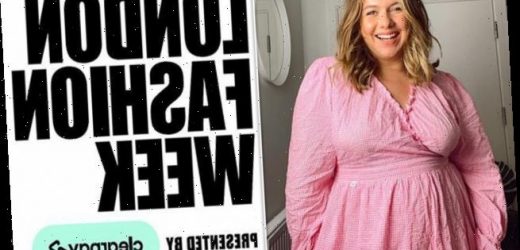The lockdown fashion lovers risking ‘pay later’ penury: Thousands of women face falling into debt due to the rise of ‘buy now, pay later’ firms during their lonely months at home… So is a new dress ever worth a life of stress and anxiety?
- Gabriella Alberti spent £1,600 on clothes and £700 on homewares in lockdown 2
- Gabriella said the ease of ‘buy-now pay-later’ also lured her into the spending
- Sophie Edwards, from Sussex, used Klarna’s ‘buy now and pay in 30 days’ feature
- Sophie, 26, had existing credit-card debt and spent a total £3,619.40 on Klarna
- Buy-now pay-later has grown fourfold across the last year of Covid lockdowns
Feeling bored in lockdown, Gabriella Alberti logged on to her computer and began browsing online shopping sites.
Many will empathise with her feelings of listlessness and isolation brought about by being cooped up at home.
Gabriella thought a few home improvements and some new clothes would give her a harmless boost. But her spending quickly got rather more out of control than she’d intended.
During the autumn lockdown she estimates she spent £1,600 on clothes and £700 on homeware.
‘Each time I went on to buy something, it seemed like I’d be able to afford it easily, especially as some things were in the sale, but now, looking at it, I got myself in a bit of difficulty,’ she admits.
Sophie Edwards, 26, from West Sussex, (pictured) used Klarna’s ‘buy now and pay in 30 days’ feature despite already having credit-card debt and ended up spending a total of £3,619.40
It wasn’t only the sale she thinks lured her in. The reason it was so easy for Gabriella’s lockdown splurge to become a financial headache was the ease with which she could buy now and pay later.
Used by five million people and responsible for £2.7 billion in sales, buy-now pay-later has grown fourfold over the past year of lockdowns.
Available at most retailers — from Marks & Spencer to Asos and many more in between, the idea is that the bill is split into three or four payments. These are then debited at later intervals, sometimes weeks and sometimes months after the purchase.
Klarna, which launched in the UK six years ago and encourages users to ‘Shop Like A Queen’ in adverts, is the best-known provider but others include Clearpay, Laybuy and Afterpay. Last Autumn Paypal also launched its Pay in 3 facility.
As Gabriella, a 26-year-old former nurse who lives in Wiltshire with her serviceman husband, found, it makes the initial amount seem very low, but can soon add up.
She used Paypal and Klarna for her purchases. ‘Each time I was spending about £250-£300. But it was only about £70 up front.
When I was purchasing, I was just thinking ‘Do I have enough money to pay that right now?’ You don’t think about the figure as a whole.’
Sometimes, there is an option to pay the total a month later. Because these services don’t charge interest, though some incur late-payment fees, they’re not considered credit and have escaped regulation.
Campaigners argue buy-now pay-later is debt by another name and is leading young people into spending more than they can afford.
The decision to have Clearpay as the headline sponsor for this month’s London Fashion Week caused controversy recently, with more than 60 MPs calling for debt warnings to be displayed alongside event promotions for the firm.
While some have used buy-now pay-later to ease financial difficulties through the pandemic, relieving boredom and stress, like Gabriella did, has been a major factor, sometimes fuelled by the firms.
Last year, Klarna was criticised for an influencer advertising campaign that encouraged people to use its services to cheer themselves up during lockdown.
The decision to have Clearpay as the sponsor for London Fashion Week (above) has caused controversy, with MPs calling for debt warnings to be displayed alongside promotions
One influencer wrote on Instagram: ‘Thank you @klarna.uk for the simple reminder that getting dressed up can be a total mood booster’, while another said: ‘@klarna.uk helping me get ready for the day ahead in lockdown and lifting my mood!’
Klarna admitted the posts ‘missed the mark’. Nevertheless, a survey by financial advice provider OpenMoney found 21 per cent were tempted into buy-now pay-later by social media advertising and reality TV influencers.
Meanwhile, 33 per cent admitted they were tackling boredom and 35 per cent admitted they use the schemes because they couldn’t afford the items they want to buy.
For Tamara Gray, the pandemic has seen her buy-now pay-later spending boom. In the last ten months the mature student from Devon, 30, estimates she’s spent well over £3,000 this way.
‘In the last week or so I spent £300 on clothes from Asos and £100 on jewellery from Pandora, as well as £200 on homewares from Shein.’
She admits one of the drivers has been the tedium of lockdown — scrolling through shopping websites in the evening with a glass of wine, when previously she would have been out with friends.
While the hours of her student supermarket job have increased, earlier in the pandemic things were tougher financially, so buy-now pay-later was the only way she could afford new things.
Still, she confesses she regularly buys things she doesn’t need.
‘Recently, I spent £200 on a North Face coat. I did need a warm coat, but then I also bought socks, jeans, pyjamas and a new top.
‘Buy-now pay-later definitely does entice me into shopping.’
These services are used mostly by younger women — 75 per cent of users are female and half are aged 25-36. Some 90 per cent of transactions involve clothes and shoes.
One survey suggests nearly two- fifths of people have struggled to repay these companies.
According to the Woolard Review, which recently finished an investigation, one in ten users already has debt somewhere else when they start using buy-now pay-later.
While not behind on her payments, Sophie Edwards, 26, an online content creator and food stylist, did have credit-card debt in the low four figures when she discovered Klarna in 2018. It appealed partly because her credit cards were maxed out.
Sophie, from West Sussex, used Klarna’s ‘buy now and pay in 30 days’ feature, where the entire bill is deferred for a month.
‘I’ve never really been a fan of changing rooms and I fell for the fact I could buy five pairs of jeans or dresses and try them all on in the comfort of my own home,’ she says.
Buy-now pay-later has grown fourfold across the last year of lockdown and is responsible for £2.7 billion in sales (stock image)
‘Because you get a certain amount of time to send things back the idea is that you only pay for what you keep.’
The problem was that more often than not she kept everything. ‘I held on to things I wouldn’t necessarily have kept because they were already in my home and I liked them,’ she explains.
‘I bought so many clothes using it that they all blend into one.’
Given her credit card debt, she now admits she shouldn’t have been using the service.
‘From what I remember it was as easy as putting in your email address and a few details. If I’d had to go through a longer process it would have rung more warning bells,’ she says.
‘Every month I was spending something like £150. Not horrible amounts but it’s still quite a chunk when you’re in your first job.’
While employed, Sophie could keep on top of her repayments. But in April 2019 she was made redundant.
‘That was when I realised how much I’d been spending, about £1,000 over the year, and how much I had been using shopping as therapy,’ Sophie says.
‘I had about £300 on my Klarna account when I was made redundant, and the 30-day payment deadline was coming up. I was thinking about how I was going to pay for it when I don’t have any money coming in.
‘That’s when it hit me that I’d been shopping wrong and spending really badly.’
Sophie scraped money together to pay off her Klarna account and rethought her shopping habits. ‘I thought I had to be on top of all the trends to fit in, or to be cool. Buy-now pay-later also feeds into fast fashion because it makes it so easy to buy so much and I’ve really tried to cut back on the amount of clothes I buy.’
Her story is echoed by Anna Shaw, 22, from Glasgow, who started using buy-now pay-later two years ago as a student.
Like Sophie, part of the attraction was that her credit cards were maxed out, with £2,000 owing over two cards. She was also at the limit of her £1,000 overdraft.
She says she spent a total of £3,619.40 on Klarna, shopping online for clothes, shoes and make-up at least once a week.
‘I know it sounds daft,’ she says, ‘but Klarna felt as if it was free because I didn’t need to pay it there and then.
‘Eventually I realised I was chasing the high of when you know a parcel is coming for you, and it’s like Christmas.’
Klarna, which launched in the UK six years ago, is the best-known provider but others include Clearpay, Laybuy and Afterpay (stock image)
Anna, a make-up artist, vowed to change her habits and through working in a call centre she finally paid off her credit-card debt this summer, before clearing her Klarna account and deleting the shopping apps on her phone.
But both she and Sophie empathise with those spending their way through lockdown and admit they’d be in a similar situation if they hadn’t already had a wake-up call.
Campaigners like Alice Tapper have long argued buy-now pay-later products should be under greater regulation.
‘People just aren’t aware that this is debt,’ she says. ‘It’s available on impulse with no wording about the risk. It feeds into a ‘buy now, worry about it later’ mindset — especially concerning when there is so much job insecurity.
‘Without wording about the risks or protection via services like the Financial Ombudsman, the odds of things going wrong are stacked against the consumer.
‘There are often strong incentives to take it up, too. For example, in September there was Clearpay Day, where chunky discounts were only available to people if they shopped with Clearpay.’
Klarna boasts on its website you need ‘never pay full price again’.
Alice is delighted that as a result of the Woolard Review, the Financial Conduct Authority recently announced plans for regulation. ‘Until now there has been no recourse to complain if things go wrong,’ she says.
Sophie, who is still paying off her credit-card debt, says: ‘I do still use it but for the right reasons. If I need to buy a pair of jeans I might buy them in two sizes to see which fits best and send the other back. I’ll make sure I have enough money in my account first too.’
Gabriella is trying to curb future sprees and looking for ways to keep on top of repayments.
‘I’m selling my Pandora jewellery collection and my Michael Kors bags — gifts from before I got together with my husband, to fund the repayments.’
If that doesn’t help she says she’ll have to ask her husband, serving abroad and yet to find out the extent of her spending, for help.
As for Tamara, she’s aware that her supermarket shifts will be cut back at some point and she’ll need to rein in her spending. How easy she’ll find it is another matter.
Source: Read Full Article






